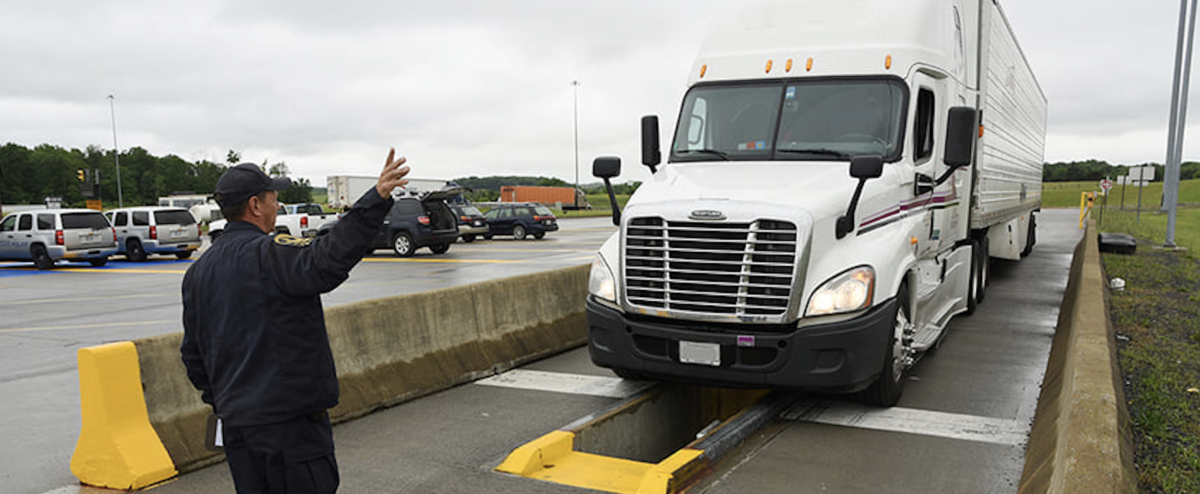Here is your Roadcheck 2022 “cheat sheet”
With International Roadcheck 2022 just a month away, the Commercial Vehicle Safety Alliance (CVSA) has shared a “cheat sheet” to help drivers prepare.
This year, International Roadcheck will take place May 17-19 at weigh and inspection stations, roving patrols and temporary inspection sites in Canada, Mexico and the United States.

Each year, ASVC selects an area of focus for the 72-hour Roadcheck campaign. Last year, inspectors focused on hours of service violations and lighting violations. This year, the focus will be on the wheel ends.
In the “cheat sheet” below, the CVSA details the vehicle components that an inspector will check during a Level I inspection.
CVSA Roadcheck Cheat Sheet
BRAKES Check for missing, non-functioning, loose, contaminated, or cracked parts on the brake system. Check the S-cam rollover. Watch for audible air leaks around brake components and lines. Check that the slack adjusters are the same length (from the center of the S-cam to the center of the clevis pin) and that the tubes on each axle are the same size. Make sure the air system maintains air pressure between 90 and 100 psi (620 and 690 kPa). Inspect for unfabricated holes (for example, rust holes, holes created by rubbing or friction, etc.) and broken springs in the spring brake housing section of the parking brake. Measure the stroke of the push rod. Inspect required brake system warning devices, such as ABS malfunction indicator lamp(s) and low air pressure warning devices. Inspect the tractor’s protection system, including the bleeding system on the trailer. Make sure the breaking system is operational on the trailer.
COUPLING DEVICES Safety Devices – Full Trailers/Conversion Cart(s): Check safety devices (chains/cables) for sufficient strength, missing components, improper repairs, and devices unable to attach securely. On the lower fifth wheel, check for unsecured frame mounting or missing or damaged parts, or any visible gaps between the upper and lower fifth wheel plates. Check that the locking jaws are around the rod and not the kingpin head and that the release lever is in place and the safety latch is engaged. Check the top fifth wheel for damage to the backing plate (and its brackets), such as cracks, loose or missing bolts on the trailer. On the sliding fifth wheel, check that the locking mechanism is correctly engaged (teeth fully engaged on the rail); also check for worn or missing parts. Make sure the position does not allow the tractor frame rails to contact the undercarriage during turns. Check for damaged or missing front and rear stops.
FUEL AND EXHAUST SYSTEMS Check your fuel tanks for the following conditions: loose fitting, leaks or other conditions; loose or missing caps; and signs of fuel leaks under the tanks. For exhaust systems, check for the following: unsecured mounting; leaks under the cabin; exhaust system components in contact with electrical wiring or brake lines and hoses; and excessive carbon deposits around seams and darts.
CHASSIS TRAILERS, BOXES AND OPEN TRAILERS Inspect corrosion fatigue; cracked, loose or missing cross members; cracks in the frame; missing or defective body parts. Look at the condition of the hoses and check the suspension of the air hoses on vehicles equipped with sliding tandems. On the frame and frame assembly, check for cracks, bends, sags, loose fasteners, or any defects that may cause the frame to collapse; corrosion; fatigue; cracked or missing crosspieces; cracks in the frame; missing or defective body parts. Inspect all axles. For vans and open-top trailer bodies, look at the top rail and check the roof bows and side pillars for warping, cracking, or ineffective fasteners. On the lower rail, check for breaks accompanied by sagging of the floor, rail or sleepers; or broken with loose or missing fasteners to the side jamb adjacent to the crack.
LIGHTING Inspect all required lamps for proper color, operation, mounting and visibility.
CARGO SECURING Be sure to carry a safe load. Check the rear panel security. Check that the end barriers are secured in the stake pockets. Check both sides of the trailer to make sure the cargo is secured against shifting or falling. Check that the rear doors are securely closed. When the load is visible, check for proper blocking and bracing. It may be necessary to examine the interior of the trailer to ensure that large items are properly secured. Check the number, size and condition of cargo securing devices. Check tie-down anchor points for warping and cracking.
STEERING Check the steering play by first turning the steering wheel in one direction until the tires begin to spin. Then place a mark on the steering wheel at a fixed reference point and turn the steering wheel in the opposite direction until the tires begin to move again. Mark the steering wheel at the same fixed reference point and measure the distance between the two marks. The amount of allowable play varies depending on the diameter of the flywheel.
SUSPENSION Inspect the suspension for: indications of misaligned, misaligned, cracked, or missing springs; loose chains; missing bolts; unsecured spring hangers; and cracked or loose U-bolts. Also check for any unsecured axle locating parts and signs of axle misalignment. On the front axle, check for obvious cracks, welds, and misalignments.
TIRES, WHEELS, RIMS AND HUBS Check tire inflation, cuts and bulges, regrooved tires on the steering axle, tread wear, and major depth of tread grooves. Inspect the sidewalls for improper repairs, exposed fabric or cord, contact with any part of the vehicle, and tire marks ruling it out of use on a steer axle. Inspect wheels and rims for cracks, loose lock rings, and broken or missing lugs, studs, or collars. Look for cracked or bent rims, loose or damaged lug nuts and elongated stud holes, cracks on the spokes or in the web area and signs of slippage in the tightening areas. Check hubs for lubricant leaks, missing plugs or caps, misalignment and positioning, and damaged, worn, or missing parts.


Comments are closed.